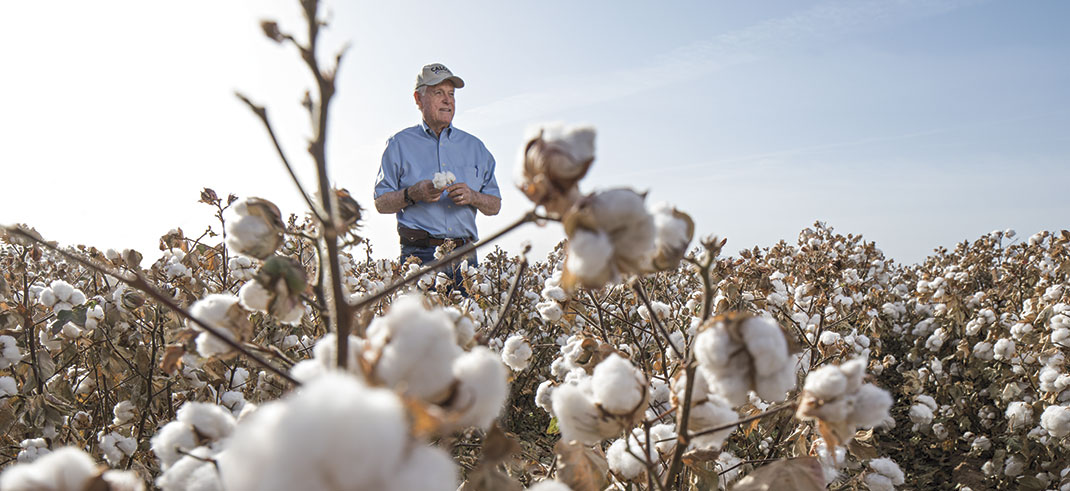By: Denise Attaway
Last year was a record year for South Carolina cotton farmers, and 2018 could be even better if the markets and weather hold out and pests remain at bay.
About 150 farmers gathered for Clemson Cooperative Extension Service’s recent annual cotton grower meeting. Nathan Smith, Clemson Extension economist and professor at the Clemson Sandhill Research and Education Center, said 2017 was a record year for farmers across the United States.
“Heading in to 2018, the cotton outlook for both South Carolina and the entire United States is looking better than (2017),” Smith said. “We’re coming off a record year for cotton yield – an average of about 900 pounds per acre – across all cotton states.”
Almost 24 million bales of cotton were produced last year. Higher production generally means lower prices. But Smith said this hasn’t been the case.
“Prices have been strong so far,” Smith said. “The price for cotton right now is above 80 cents per pound for the 2017 crop. Prices for the 2018 cotton crop have reached 75 cents per pound. The outlook is better for the cotton crop in 2018, but we’ll have to wait and see how growers respond and what their planting intentions are.”
A total of 250,000 acres of cotton were planted in South Carolina in 2017, said Mike Jones, South Carolina cotton specialist housed at the Clemson Pee Dee Research and Education Center. This was up from 190,000 acres of cotton planted in South Carolina in 2016.
“Cotton quality is the best it has been in a while,” Jones said. “We had good, timely rainfall most of the growing season and mild temperatures in June, July and August. Moderate temperatures and adequate rainfall combined resulted in favorable conditions for an outstanding, high-quality cotton crop in South Carolina in 2017.”
Variety selection also plays an important role in cotton quality and yield. When considering a cotton variety to plant, Jones said it is important to look at all available data on the variety.
“Select varieties based on yield potential and yield stability,” Jones said. “Look at all the data so that you can spread your risks.”
South Carolina cotton growers will have several varieties to choose from this year. Representatives from Americot, Bayer CropScience, Deltapine (Monsanto) and PhytoGen (Dow AgroSciences) talked about new varieties available this year.
In addition to variety information, cotton growers also need to know about controlling pests, such as insects, weeds and diseases. To help growers reap the greatest benefits from their crops, Jones encourages all growers to use the South Carolina Cotton Growers’ Guide, available online. This guide provides tips that can be key to profitable cotton production in South Carolina. More cotton information from the Clemson staff can also be found online.
In a discussion about insect pests, Jeremy Greene, professor of entomology at the Edisto Research and Education Center, assured growers they would see thrips in their cotton crop every year. Growers can reduce risk from thrips by planting later in the normal window of planting, Greene said.
A new tool also is available to assist growers in their fight against thrips.
“We worked with researchers at North Carolina State University to develop a good online tool for predicting risks from thrips in cotton,” Greene said.
Growers will learn more about this new tool during production meetings this spring.
Hugh Weathers, South Carolina commissioner of agriculture, attended the meeting to talk about growing industrial hemp in South Carolina, the 2018 Farm Bill and other programs, such as City Roots Farm.
“We’ve stressed crop diversification for years, and now we’re going to get it,” Weathers said. “We’ve selected 20 licensees, farmers, who can grow up to 20 acres each for the Hemp Pilot Program. We’re going to see how this crop will blend in in South Carolina.”
Hemp growers plant their first crops this spring (2018).
One of the meeting’s attendees, James Collins of Olar, has been farming in Bamberg County since 1953. He and his grandson, Jade, attend the cotton growers meeting every year. Jade Collins has been farming for about 10 years.
“Farmers have to keep up with what’s going on in the (cotton) industry,” James Collins said. “They have to keep up with the latest technology and research so they’ll know what to do with their crops.”
About 80% of the South Carolina cotton crop is planted the first week in May. Cotton harvest begins in late September.
Source: Cotton Grower

